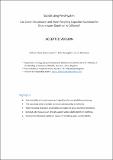Substituting freshwater : can ocean desalination and water recycling capacities substitute for groundwater depletion in California?
Abstract
While the sustainability of resource depletion is a longstanding environmental concern, wider attention has recently been given to growing water scarcity and groundwater depletion. This study seeks to test the substitutability assumption embedded in weak sustainability indicators using a case study of Californian water supply. The volume of groundwater depletion is used as a proxy for unsustainable water consumption, and defined by synthesising existing research estimates into low, medium and high depletion baselines. These are compared against projected water supply increases from ocean desalination and water recycling by 2035, to determine whether new, drought-proof water sources can substitute for currently unsustainable groundwater consumption. Results show that the maximum projected supply of new water, 2.47 million acre-feet per year (MAF/yr), is sufficient to meet low depletion estimates of 2.02 MAF/yr, but fails to come near the high depletion estimate of 3.44 MAF/yr. This does not necessarily indicate physical limitations of substitutability, but more so socio-economic limitations influenced by high comparative costs. By including capacities in demand-substitutability via urban water conservation, maximum predicted capacities reach 5.57 MAF/yr, indicating wide room for substitution. Based on these results, investment in social and institutional capital is an important factor to enhance demand-side substitutability of water and other natural resources, which has been somewhat neglected by the literature on the substitutability of natural resources.
Citation
Badiuzzaman , P , McLaughlin , E & McCauley , D 2017 , ' Substituting freshwater : can ocean desalination and water recycling capacities substitute for groundwater depletion in California? ' , Journal of Environmental Management , vol. 203 , no. Part 1 , pp. 123-135 . https://doi.org/10.1016/j.jenvman.2017.06.051
Publication
Journal of Environmental Management
Status
Peer reviewed
ISSN
0301-4797Type
Journal article
Collections
Items in the St Andrews Research Repository are protected by copyright, with all rights reserved, unless otherwise indicated.

